Ethical Leadership and Management in the ASOS Supply Chain
VerifiedAdded on 2020/10/05
|13
|3800
|331
Report
AI Summary
This report examines the ethical dimensions of the ASOS supply chain, focusing on issues such as child labor and worker exploitation. It identifies violations of ethical standards and analyzes the impact on stakeholders, including customers, investors, and employees. The report explores the role of ethical leadership in mitigating these issues and discusses the application of ethical theories, specifically virtue and feminist ethics, to the case study. It emphasizes the importance of implementing monitoring committees, strict guidelines, and improved communication channels to ensure ethical practices throughout the supply chain. The analysis highlights the negative consequences of unethical behavior on brand image and business performance, and it provides recommendations for ASOS to improve its ethical management and maintain long-term stakeholder relationships. The report concludes by stressing the need for organizations to prioritize ethical considerations alongside profit maximization.
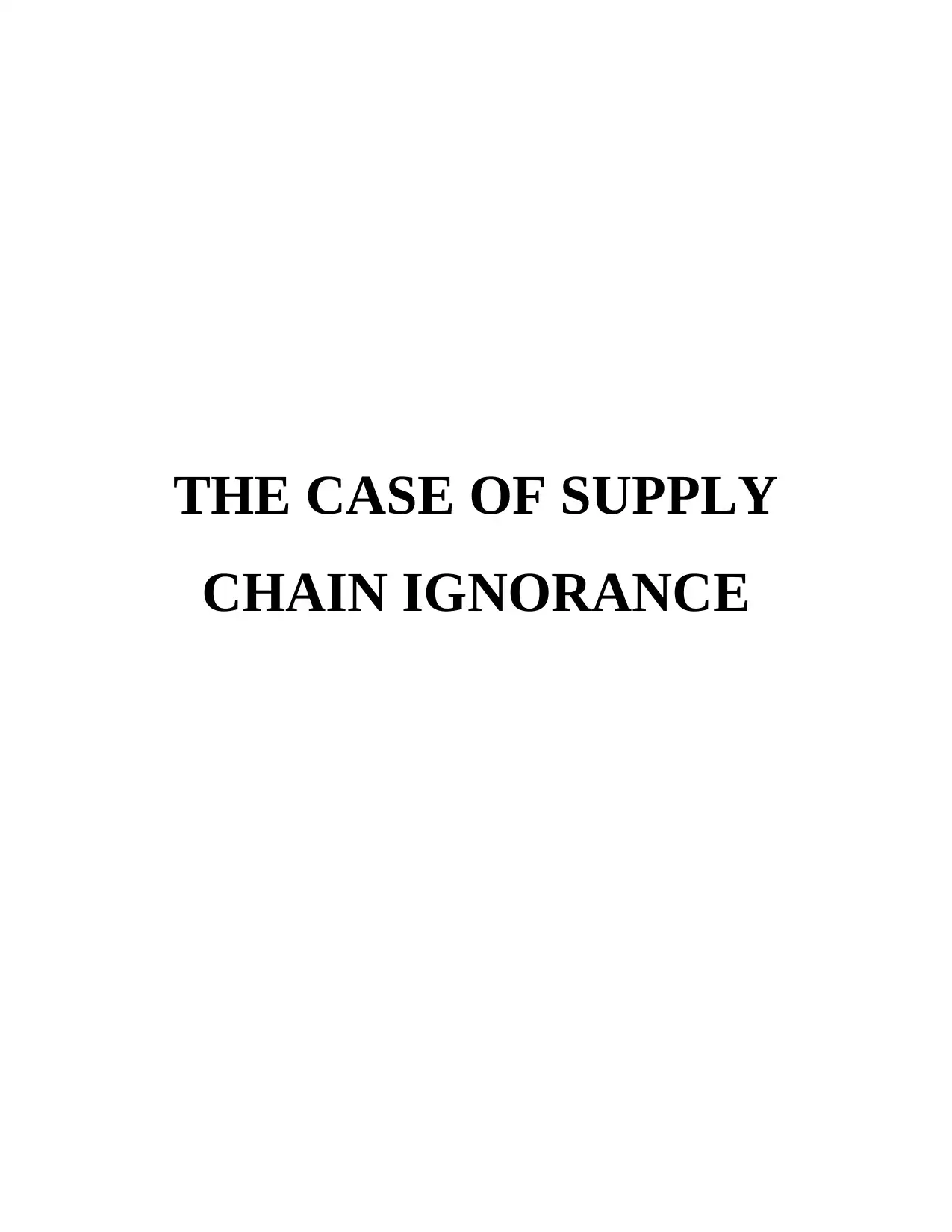
THE CASE OF SUPPLY
CHAIN IGNORANCE
CHAIN IGNORANCE
Paraphrase This Document
Need a fresh take? Get an instant paraphrase of this document with our AI Paraphraser
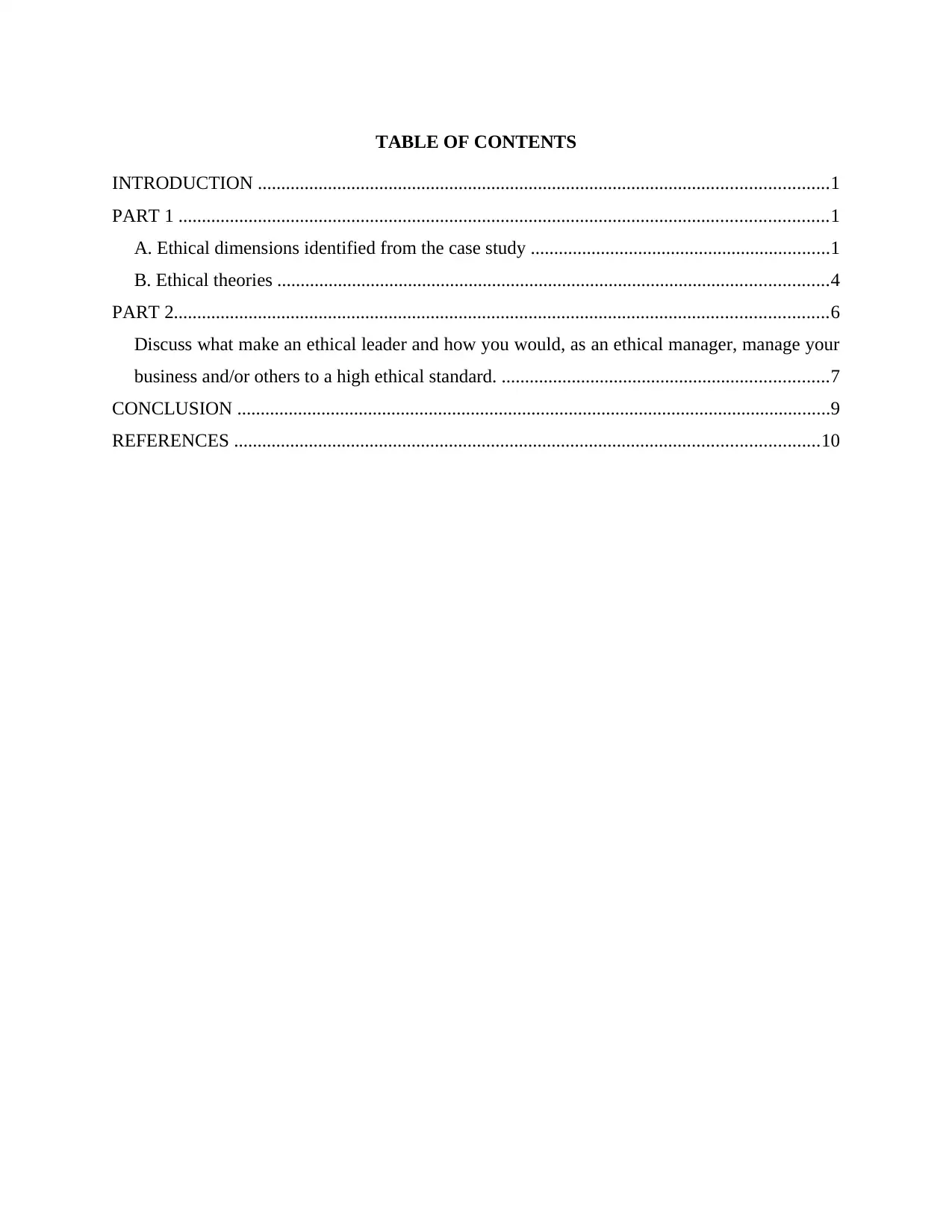
TABLE OF CONTENTS
INTRODUCTION ..........................................................................................................................1
PART 1 ...........................................................................................................................................1
A. Ethical dimensions identified from the case study ................................................................1
B. Ethical theories ......................................................................................................................4
PART 2............................................................................................................................................6
Discuss what make an ethical leader and how you would, as an ethical manager, manage your
business and/or others to a high ethical standard. ......................................................................7
CONCLUSION ...............................................................................................................................9
REFERENCES .............................................................................................................................10
INTRODUCTION ..........................................................................................................................1
PART 1 ...........................................................................................................................................1
A. Ethical dimensions identified from the case study ................................................................1
B. Ethical theories ......................................................................................................................4
PART 2............................................................................................................................................6
Discuss what make an ethical leader and how you would, as an ethical manager, manage your
business and/or others to a high ethical standard. ......................................................................7
CONCLUSION ...............................................................................................................................9
REFERENCES .............................................................................................................................10

INTRODUCTION
The ethical management is defined as the strategy which establishes an alignment
between legal regulations, economic goals and ethical expectations which are imposed by
various norms. The ethics are applied on behaviour of individuals as well as on different
operational procedures followed by the business. The ethics in business practices ensures that the
rights of all individuals are protected and business activities are performed with approved legal
and social constraints (Bailey and et.al., 2018). Business ethics refers to valid and acceptable
policies and methods on issues such as discrimination, governance, corporate social
responsibility and insider trading.
The report will analyse the ethical management practices in given case study of ASOS.
The organisation is one of the well known cosmetic and online retailers providing its services
online. The organisation supplies its goods to more than 200 countries. However, there have
been reports indicating the unethical practices such as exploitation of the labours and
engagement of child labours in supply chain of the company. The report will discuss the various
ethical dimensions of the matter and their impact on the overall business performance. It will
also analyse the implementation of various ethical theories in the given case study of ASOS.
Further the study will describe the role of leaders in implementing ethical standards in business
and significance of individual ethics in influencing the compliance and ethical practices of the
organisation.
PART 1
A. Ethical dimensions identified from the case study
In the supply chain management of ASOS it is analysed that several ethical
considerations are violated. Despite bringing such issues in notice the organisation is not
concerned to take the responsibility. The child labour is strictly not allowed but in the Turkish
factory children were forced to work for several hours and were not able to go even schools. The
working conditions in which they were working were also not safe. Along with the children most
of the workers in factory belongs to refugees (Child Workers Found In Clothing Supply Chain:
ASOS, Marks & Spencer Implicated, 2016). Thus, in the name of providing support to these
needy people they are exploited by means of low wages, unsafe working conditions.
1
The ethical management is defined as the strategy which establishes an alignment
between legal regulations, economic goals and ethical expectations which are imposed by
various norms. The ethics are applied on behaviour of individuals as well as on different
operational procedures followed by the business. The ethics in business practices ensures that the
rights of all individuals are protected and business activities are performed with approved legal
and social constraints (Bailey and et.al., 2018). Business ethics refers to valid and acceptable
policies and methods on issues such as discrimination, governance, corporate social
responsibility and insider trading.
The report will analyse the ethical management practices in given case study of ASOS.
The organisation is one of the well known cosmetic and online retailers providing its services
online. The organisation supplies its goods to more than 200 countries. However, there have
been reports indicating the unethical practices such as exploitation of the labours and
engagement of child labours in supply chain of the company. The report will discuss the various
ethical dimensions of the matter and their impact on the overall business performance. It will
also analyse the implementation of various ethical theories in the given case study of ASOS.
Further the study will describe the role of leaders in implementing ethical standards in business
and significance of individual ethics in influencing the compliance and ethical practices of the
organisation.
PART 1
A. Ethical dimensions identified from the case study
In the supply chain management of ASOS it is analysed that several ethical
considerations are violated. Despite bringing such issues in notice the organisation is not
concerned to take the responsibility. The child labour is strictly not allowed but in the Turkish
factory children were forced to work for several hours and were not able to go even schools. The
working conditions in which they were working were also not safe. Along with the children most
of the workers in factory belongs to refugees (Child Workers Found In Clothing Supply Chain:
ASOS, Marks & Spencer Implicated, 2016). Thus, in the name of providing support to these
needy people they are exploited by means of low wages, unsafe working conditions.
1
⊘ This is a preview!⊘
Do you want full access?
Subscribe today to unlock all pages.

Trusted by 1+ million students worldwide
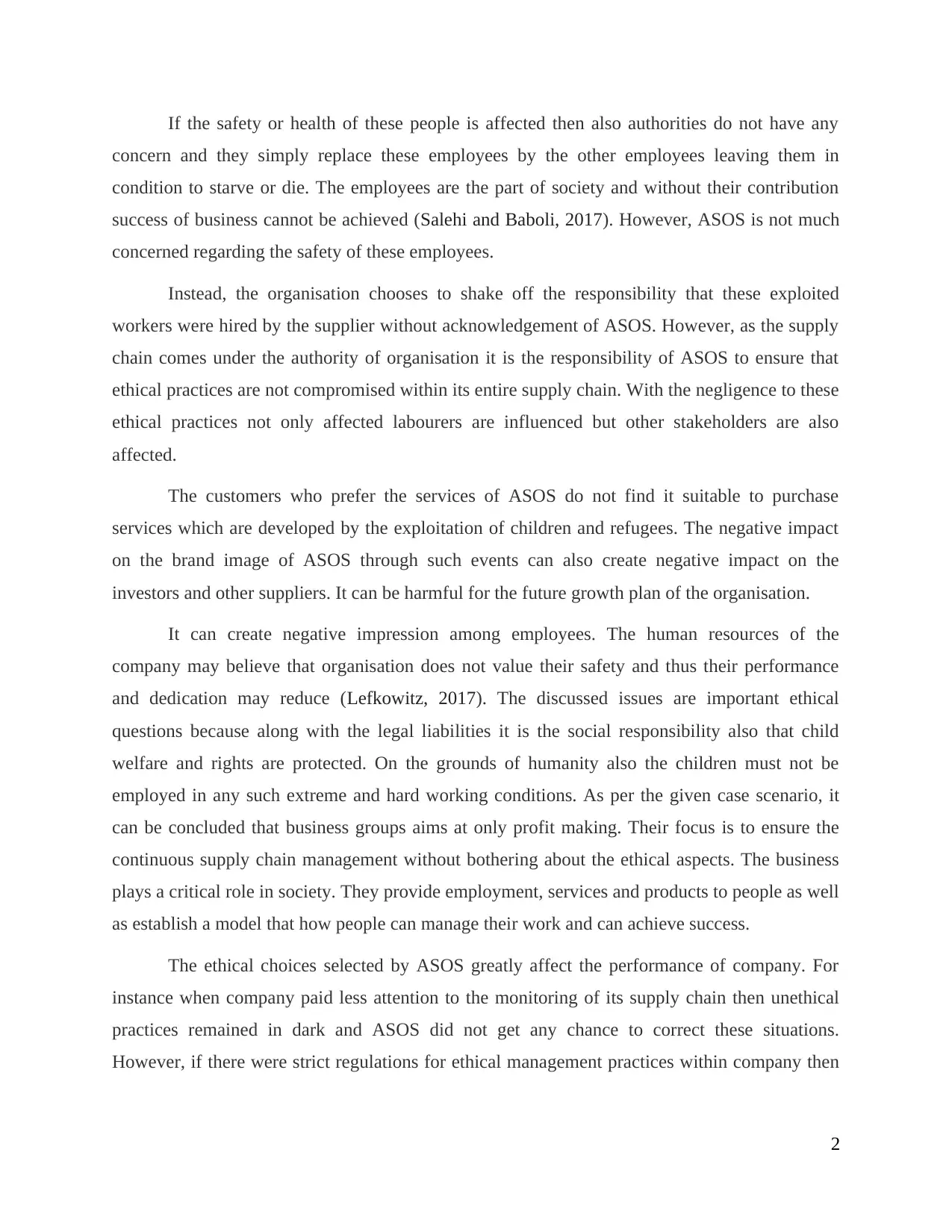
If the safety or health of these people is affected then also authorities do not have any
concern and they simply replace these employees by the other employees leaving them in
condition to starve or die. The employees are the part of society and without their contribution
success of business cannot be achieved (Salehi and Baboli, 2017). However, ASOS is not much
concerned regarding the safety of these employees.
Instead, the organisation chooses to shake off the responsibility that these exploited
workers were hired by the supplier without acknowledgement of ASOS. However, as the supply
chain comes under the authority of organisation it is the responsibility of ASOS to ensure that
ethical practices are not compromised within its entire supply chain. With the negligence to these
ethical practices not only affected labourers are influenced but other stakeholders are also
affected.
The customers who prefer the services of ASOS do not find it suitable to purchase
services which are developed by the exploitation of children and refugees. The negative impact
on the brand image of ASOS through such events can also create negative impact on the
investors and other suppliers. It can be harmful for the future growth plan of the organisation.
It can create negative impression among employees. The human resources of the
company may believe that organisation does not value their safety and thus their performance
and dedication may reduce (Lefkowitz, 2017). The discussed issues are important ethical
questions because along with the legal liabilities it is the social responsibility also that child
welfare and rights are protected. On the grounds of humanity also the children must not be
employed in any such extreme and hard working conditions. As per the given case scenario, it
can be concluded that business groups aims at only profit making. Their focus is to ensure the
continuous supply chain management without bothering about the ethical aspects. The business
plays a critical role in society. They provide employment, services and products to people as well
as establish a model that how people can manage their work and can achieve success.
The ethical choices selected by ASOS greatly affect the performance of company. For
instance when company paid less attention to the monitoring of its supply chain then unethical
practices remained in dark and ASOS did not get any chance to correct these situations.
However, if there were strict regulations for ethical management practices within company then
2
concern and they simply replace these employees by the other employees leaving them in
condition to starve or die. The employees are the part of society and without their contribution
success of business cannot be achieved (Salehi and Baboli, 2017). However, ASOS is not much
concerned regarding the safety of these employees.
Instead, the organisation chooses to shake off the responsibility that these exploited
workers were hired by the supplier without acknowledgement of ASOS. However, as the supply
chain comes under the authority of organisation it is the responsibility of ASOS to ensure that
ethical practices are not compromised within its entire supply chain. With the negligence to these
ethical practices not only affected labourers are influenced but other stakeholders are also
affected.
The customers who prefer the services of ASOS do not find it suitable to purchase
services which are developed by the exploitation of children and refugees. The negative impact
on the brand image of ASOS through such events can also create negative impact on the
investors and other suppliers. It can be harmful for the future growth plan of the organisation.
It can create negative impression among employees. The human resources of the
company may believe that organisation does not value their safety and thus their performance
and dedication may reduce (Lefkowitz, 2017). The discussed issues are important ethical
questions because along with the legal liabilities it is the social responsibility also that child
welfare and rights are protected. On the grounds of humanity also the children must not be
employed in any such extreme and hard working conditions. As per the given case scenario, it
can be concluded that business groups aims at only profit making. Their focus is to ensure the
continuous supply chain management without bothering about the ethical aspects. The business
plays a critical role in society. They provide employment, services and products to people as well
as establish a model that how people can manage their work and can achieve success.
The ethical choices selected by ASOS greatly affect the performance of company. For
instance when company paid less attention to the monitoring of its supply chain then unethical
practices remained in dark and ASOS did not get any chance to correct these situations.
However, if there were strict regulations for ethical management practices within company then
2
Paraphrase This Document
Need a fresh take? Get an instant paraphrase of this document with our AI Paraphraser
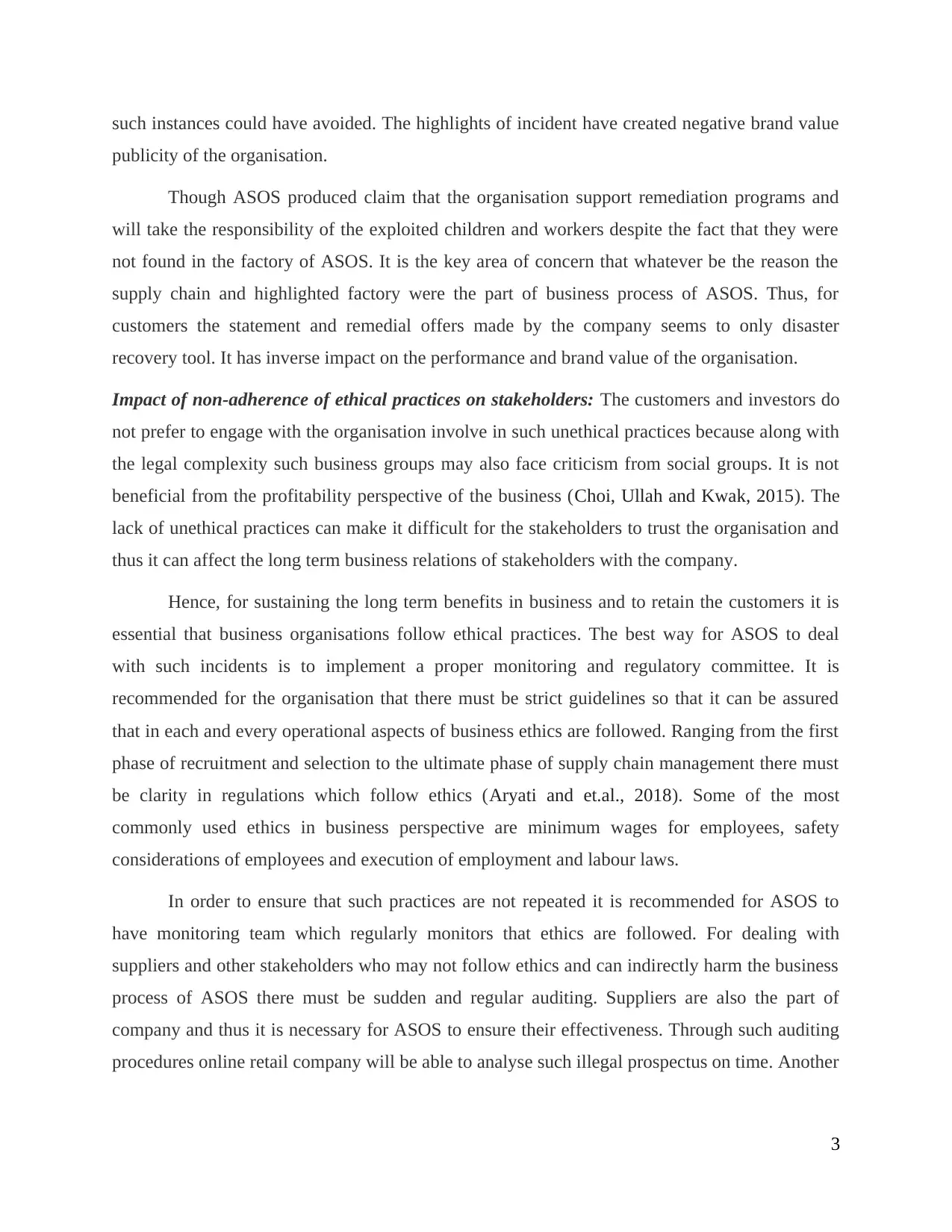
such instances could have avoided. The highlights of incident have created negative brand value
publicity of the organisation.
Though ASOS produced claim that the organisation support remediation programs and
will take the responsibility of the exploited children and workers despite the fact that they were
not found in the factory of ASOS. It is the key area of concern that whatever be the reason the
supply chain and highlighted factory were the part of business process of ASOS. Thus, for
customers the statement and remedial offers made by the company seems to only disaster
recovery tool. It has inverse impact on the performance and brand value of the organisation.
Impact of non-adherence of ethical practices on stakeholders: The customers and investors do
not prefer to engage with the organisation involve in such unethical practices because along with
the legal complexity such business groups may also face criticism from social groups. It is not
beneficial from the profitability perspective of the business (Choi, Ullah and Kwak, 2015). The
lack of unethical practices can make it difficult for the stakeholders to trust the organisation and
thus it can affect the long term business relations of stakeholders with the company.
Hence, for sustaining the long term benefits in business and to retain the customers it is
essential that business organisations follow ethical practices. The best way for ASOS to deal
with such incidents is to implement a proper monitoring and regulatory committee. It is
recommended for the organisation that there must be strict guidelines so that it can be assured
that in each and every operational aspects of business ethics are followed. Ranging from the first
phase of recruitment and selection to the ultimate phase of supply chain management there must
be clarity in regulations which follow ethics (Aryati and et.al., 2018). Some of the most
commonly used ethics in business perspective are minimum wages for employees, safety
considerations of employees and execution of employment and labour laws.
In order to ensure that such practices are not repeated it is recommended for ASOS to
have monitoring team which regularly monitors that ethics are followed. For dealing with
suppliers and other stakeholders who may not follow ethics and can indirectly harm the business
process of ASOS there must be sudden and regular auditing. Suppliers are also the part of
company and thus it is necessary for ASOS to ensure their effectiveness. Through such auditing
procedures online retail company will be able to analyse such illegal prospectus on time. Another
3
publicity of the organisation.
Though ASOS produced claim that the organisation support remediation programs and
will take the responsibility of the exploited children and workers despite the fact that they were
not found in the factory of ASOS. It is the key area of concern that whatever be the reason the
supply chain and highlighted factory were the part of business process of ASOS. Thus, for
customers the statement and remedial offers made by the company seems to only disaster
recovery tool. It has inverse impact on the performance and brand value of the organisation.
Impact of non-adherence of ethical practices on stakeholders: The customers and investors do
not prefer to engage with the organisation involve in such unethical practices because along with
the legal complexity such business groups may also face criticism from social groups. It is not
beneficial from the profitability perspective of the business (Choi, Ullah and Kwak, 2015). The
lack of unethical practices can make it difficult for the stakeholders to trust the organisation and
thus it can affect the long term business relations of stakeholders with the company.
Hence, for sustaining the long term benefits in business and to retain the customers it is
essential that business organisations follow ethical practices. The best way for ASOS to deal
with such incidents is to implement a proper monitoring and regulatory committee. It is
recommended for the organisation that there must be strict guidelines so that it can be assured
that in each and every operational aspects of business ethics are followed. Ranging from the first
phase of recruitment and selection to the ultimate phase of supply chain management there must
be clarity in regulations which follow ethics (Aryati and et.al., 2018). Some of the most
commonly used ethics in business perspective are minimum wages for employees, safety
considerations of employees and execution of employment and labour laws.
In order to ensure that such practices are not repeated it is recommended for ASOS to
have monitoring team which regularly monitors that ethics are followed. For dealing with
suppliers and other stakeholders who may not follow ethics and can indirectly harm the business
process of ASOS there must be sudden and regular auditing. Suppliers are also the part of
company and thus it is necessary for ASOS to ensure their effectiveness. Through such auditing
procedures online retail company will be able to analyse such illegal prospectus on time. Another
3
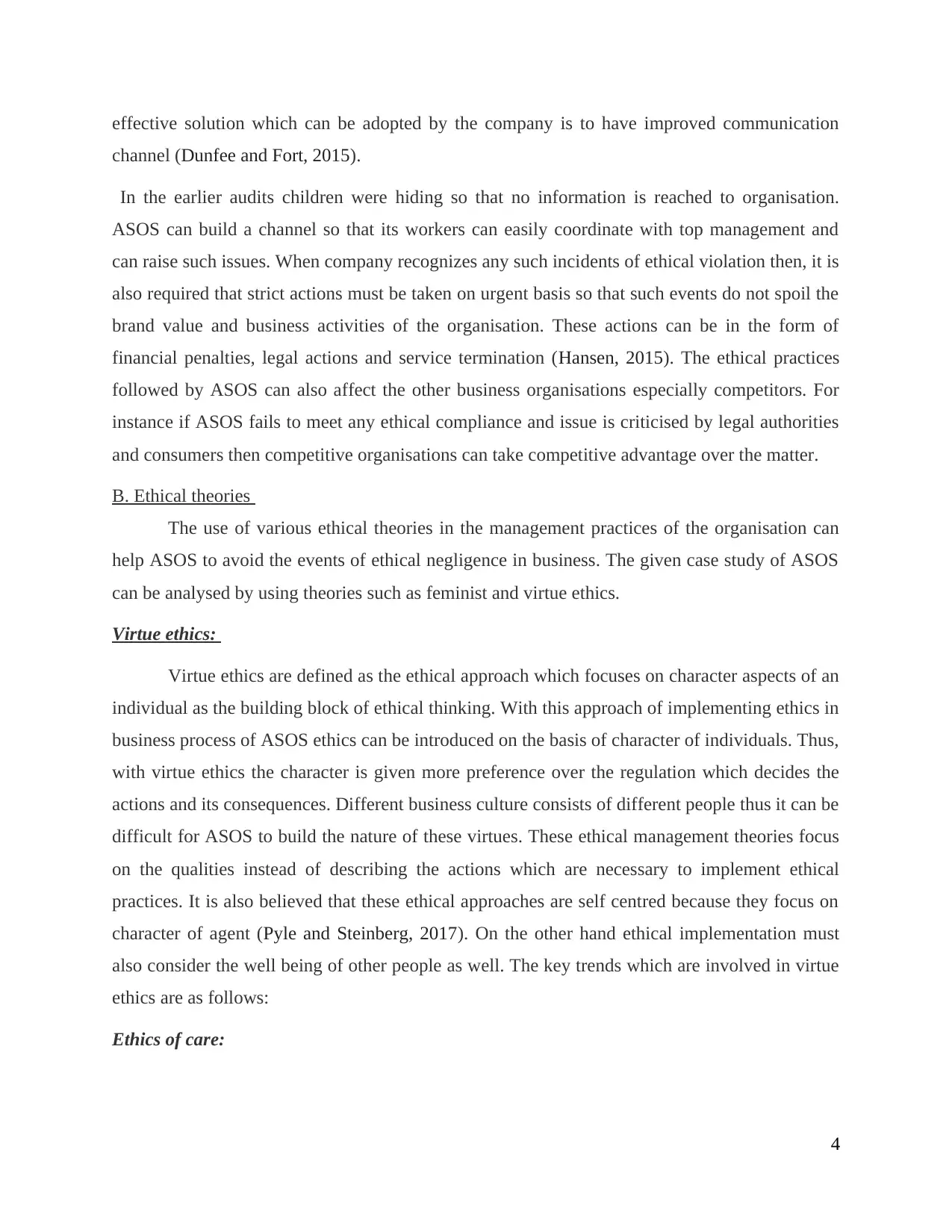
effective solution which can be adopted by the company is to have improved communication
channel (Dunfee and Fort, 2015).
In the earlier audits children were hiding so that no information is reached to organisation.
ASOS can build a channel so that its workers can easily coordinate with top management and
can raise such issues. When company recognizes any such incidents of ethical violation then, it is
also required that strict actions must be taken on urgent basis so that such events do not spoil the
brand value and business activities of the organisation. These actions can be in the form of
financial penalties, legal actions and service termination (Hansen, 2015). The ethical practices
followed by ASOS can also affect the other business organisations especially competitors. For
instance if ASOS fails to meet any ethical compliance and issue is criticised by legal authorities
and consumers then competitive organisations can take competitive advantage over the matter.
B. Ethical theories
The use of various ethical theories in the management practices of the organisation can
help ASOS to avoid the events of ethical negligence in business. The given case study of ASOS
can be analysed by using theories such as feminist and virtue ethics.
Virtue ethics:
Virtue ethics are defined as the ethical approach which focuses on character aspects of an
individual as the building block of ethical thinking. With this approach of implementing ethics in
business process of ASOS ethics can be introduced on the basis of character of individuals. Thus,
with virtue ethics the character is given more preference over the regulation which decides the
actions and its consequences. Different business culture consists of different people thus it can be
difficult for ASOS to build the nature of these virtues. These ethical management theories focus
on the qualities instead of describing the actions which are necessary to implement ethical
practices. It is also believed that these ethical approaches are self centred because they focus on
character of agent (Pyle and Steinberg, 2017). On the other hand ethical implementation must
also consider the well being of other people as well. The key trends which are involved in virtue
ethics are as follows:
Ethics of care:
4
channel (Dunfee and Fort, 2015).
In the earlier audits children were hiding so that no information is reached to organisation.
ASOS can build a channel so that its workers can easily coordinate with top management and
can raise such issues. When company recognizes any such incidents of ethical violation then, it is
also required that strict actions must be taken on urgent basis so that such events do not spoil the
brand value and business activities of the organisation. These actions can be in the form of
financial penalties, legal actions and service termination (Hansen, 2015). The ethical practices
followed by ASOS can also affect the other business organisations especially competitors. For
instance if ASOS fails to meet any ethical compliance and issue is criticised by legal authorities
and consumers then competitive organisations can take competitive advantage over the matter.
B. Ethical theories
The use of various ethical theories in the management practices of the organisation can
help ASOS to avoid the events of ethical negligence in business. The given case study of ASOS
can be analysed by using theories such as feminist and virtue ethics.
Virtue ethics:
Virtue ethics are defined as the ethical approach which focuses on character aspects of an
individual as the building block of ethical thinking. With this approach of implementing ethics in
business process of ASOS ethics can be introduced on the basis of character of individuals. Thus,
with virtue ethics the character is given more preference over the regulation which decides the
actions and its consequences. Different business culture consists of different people thus it can be
difficult for ASOS to build the nature of these virtues. These ethical management theories focus
on the qualities instead of describing the actions which are necessary to implement ethical
practices. It is also believed that these ethical approaches are self centred because they focus on
character of agent (Pyle and Steinberg, 2017). On the other hand ethical implementation must
also consider the well being of other people as well. The key trends which are involved in virtue
ethics are as follows:
Ethics of care:
4
⊘ This is a preview!⊘
Do you want full access?
Subscribe today to unlock all pages.

Trusted by 1+ million students worldwide
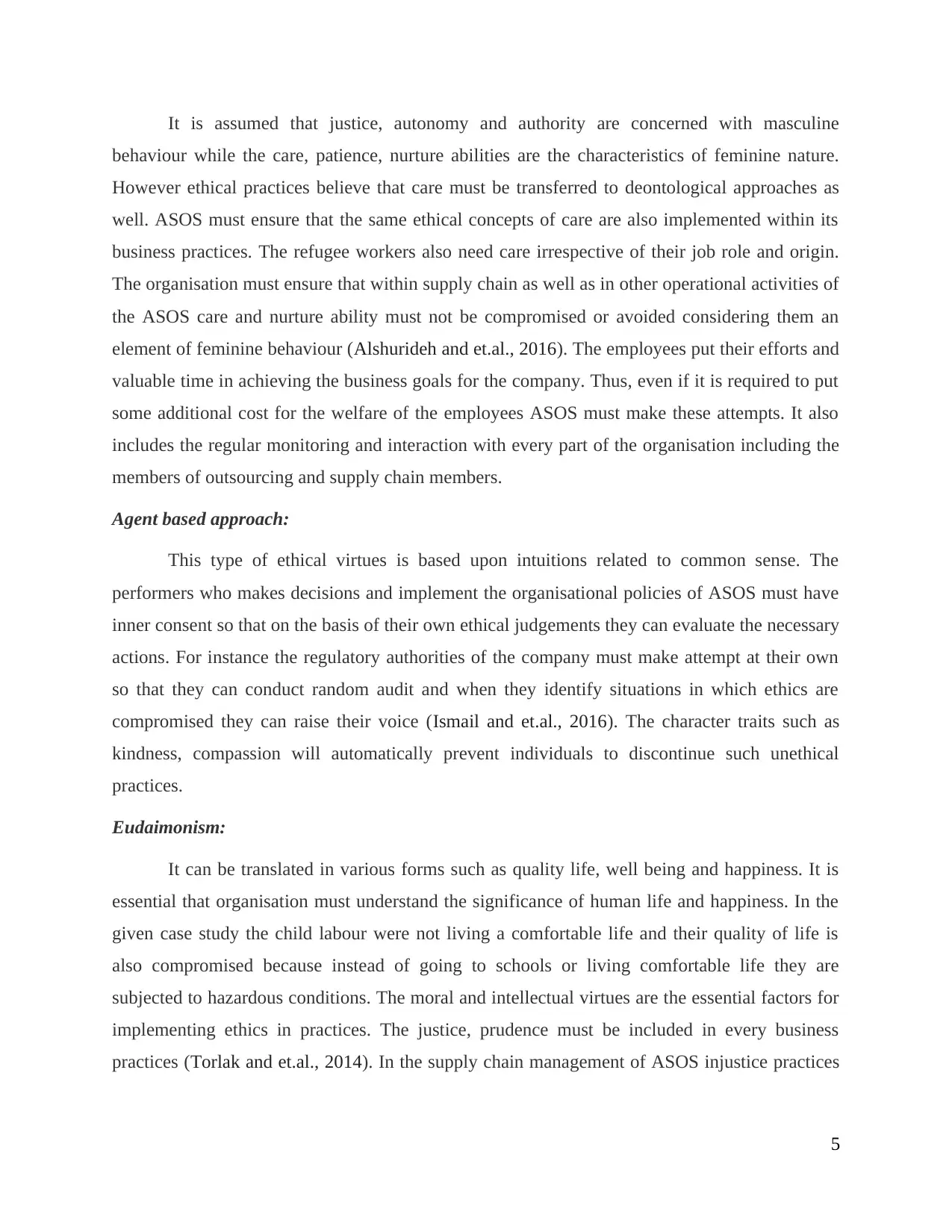
It is assumed that justice, autonomy and authority are concerned with masculine
behaviour while the care, patience, nurture abilities are the characteristics of feminine nature.
However ethical practices believe that care must be transferred to deontological approaches as
well. ASOS must ensure that the same ethical concepts of care are also implemented within its
business practices. The refugee workers also need care irrespective of their job role and origin.
The organisation must ensure that within supply chain as well as in other operational activities of
the ASOS care and nurture ability must not be compromised or avoided considering them an
element of feminine behaviour (Alshurideh and et.al., 2016). The employees put their efforts and
valuable time in achieving the business goals for the company. Thus, even if it is required to put
some additional cost for the welfare of the employees ASOS must make these attempts. It also
includes the regular monitoring and interaction with every part of the organisation including the
members of outsourcing and supply chain members.
Agent based approach:
This type of ethical virtues is based upon intuitions related to common sense. The
performers who makes decisions and implement the organisational policies of ASOS must have
inner consent so that on the basis of their own ethical judgements they can evaluate the necessary
actions. For instance the regulatory authorities of the company must make attempt at their own
so that they can conduct random audit and when they identify situations in which ethics are
compromised they can raise their voice (Ismail and et.al., 2016). The character traits such as
kindness, compassion will automatically prevent individuals to discontinue such unethical
practices.
Eudaimonism:
It can be translated in various forms such as quality life, well being and happiness. It is
essential that organisation must understand the significance of human life and happiness. In the
given case study the child labour were not living a comfortable life and their quality of life is
also compromised because instead of going to schools or living comfortable life they are
subjected to hazardous conditions. The moral and intellectual virtues are the essential factors for
implementing ethics in practices. The justice, prudence must be included in every business
practices (Torlak and et.al., 2014). In the supply chain management of ASOS injustice practices
5
behaviour while the care, patience, nurture abilities are the characteristics of feminine nature.
However ethical practices believe that care must be transferred to deontological approaches as
well. ASOS must ensure that the same ethical concepts of care are also implemented within its
business practices. The refugee workers also need care irrespective of their job role and origin.
The organisation must ensure that within supply chain as well as in other operational activities of
the ASOS care and nurture ability must not be compromised or avoided considering them an
element of feminine behaviour (Alshurideh and et.al., 2016). The employees put their efforts and
valuable time in achieving the business goals for the company. Thus, even if it is required to put
some additional cost for the welfare of the employees ASOS must make these attempts. It also
includes the regular monitoring and interaction with every part of the organisation including the
members of outsourcing and supply chain members.
Agent based approach:
This type of ethical virtues is based upon intuitions related to common sense. The
performers who makes decisions and implement the organisational policies of ASOS must have
inner consent so that on the basis of their own ethical judgements they can evaluate the necessary
actions. For instance the regulatory authorities of the company must make attempt at their own
so that they can conduct random audit and when they identify situations in which ethics are
compromised they can raise their voice (Ismail and et.al., 2016). The character traits such as
kindness, compassion will automatically prevent individuals to discontinue such unethical
practices.
Eudaimonism:
It can be translated in various forms such as quality life, well being and happiness. It is
essential that organisation must understand the significance of human life and happiness. In the
given case study the child labour were not living a comfortable life and their quality of life is
also compromised because instead of going to schools or living comfortable life they are
subjected to hazardous conditions. The moral and intellectual virtues are the essential factors for
implementing ethics in practices. The justice, prudence must be included in every business
practices (Torlak and et.al., 2014). In the supply chain management of ASOS injustice practices
5
Paraphrase This Document
Need a fresh take? Get an instant paraphrase of this document with our AI Paraphraser
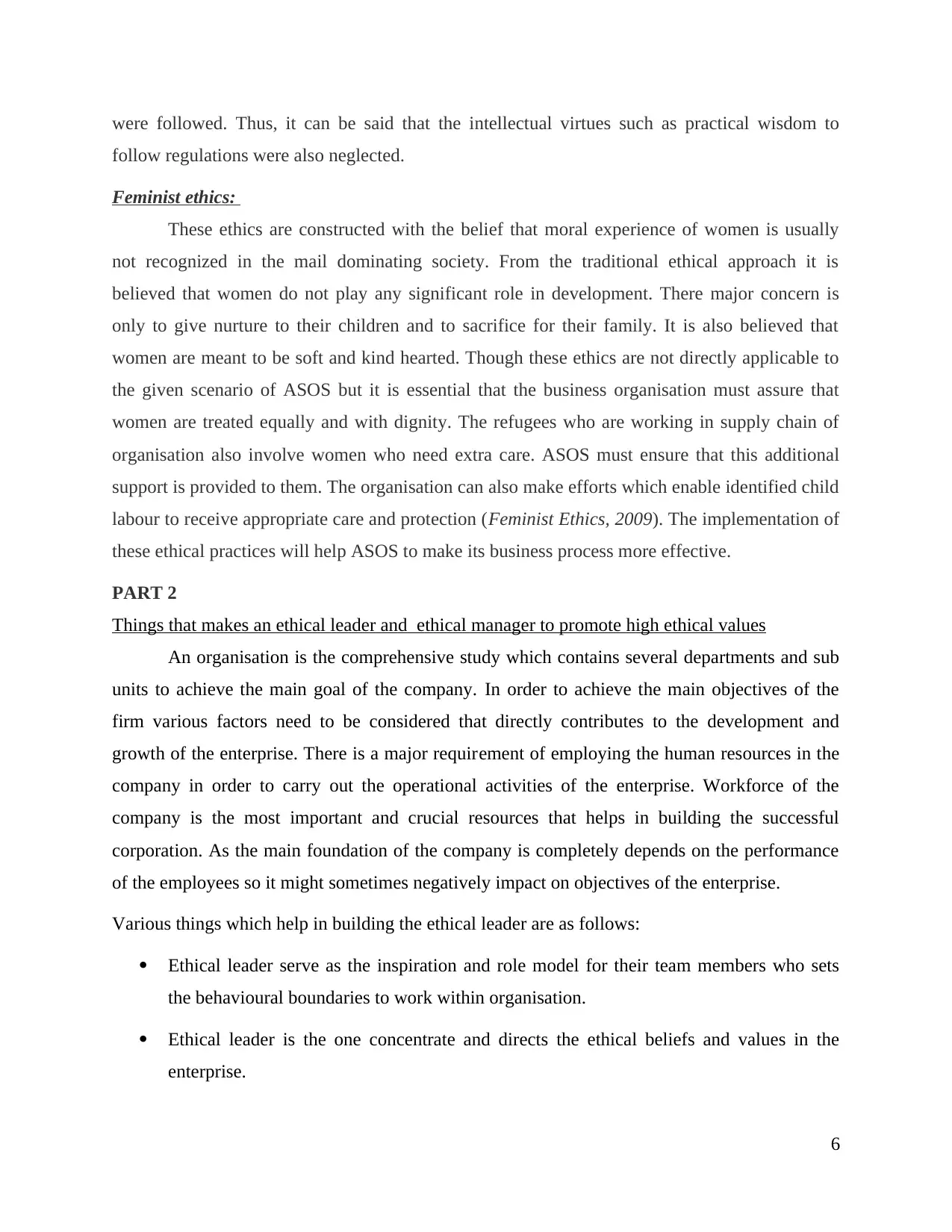
were followed. Thus, it can be said that the intellectual virtues such as practical wisdom to
follow regulations were also neglected.
Feminist ethics:
These ethics are constructed with the belief that moral experience of women is usually
not recognized in the mail dominating society. From the traditional ethical approach it is
believed that women do not play any significant role in development. There major concern is
only to give nurture to their children and to sacrifice for their family. It is also believed that
women are meant to be soft and kind hearted. Though these ethics are not directly applicable to
the given scenario of ASOS but it is essential that the business organisation must assure that
women are treated equally and with dignity. The refugees who are working in supply chain of
organisation also involve women who need extra care. ASOS must ensure that this additional
support is provided to them. The organisation can also make efforts which enable identified child
labour to receive appropriate care and protection (Feminist Ethics, 2009). The implementation of
these ethical practices will help ASOS to make its business process more effective.
PART 2
Things that makes an ethical leader and ethical manager to promote high ethical values
An organisation is the comprehensive study which contains several departments and sub
units to achieve the main goal of the company. In order to achieve the main objectives of the
firm various factors need to be considered that directly contributes to the development and
growth of the enterprise. There is a major requirement of employing the human resources in the
company in order to carry out the operational activities of the enterprise. Workforce of the
company is the most important and crucial resources that helps in building the successful
corporation. As the main foundation of the company is completely depends on the performance
of the employees so it might sometimes negatively impact on objectives of the enterprise.
Various things which help in building the ethical leader are as follows:
Ethical leader serve as the inspiration and role model for their team members who sets
the behavioural boundaries to work within organisation.
Ethical leader is the one concentrate and directs the ethical beliefs and values in the
enterprise.
6
follow regulations were also neglected.
Feminist ethics:
These ethics are constructed with the belief that moral experience of women is usually
not recognized in the mail dominating society. From the traditional ethical approach it is
believed that women do not play any significant role in development. There major concern is
only to give nurture to their children and to sacrifice for their family. It is also believed that
women are meant to be soft and kind hearted. Though these ethics are not directly applicable to
the given scenario of ASOS but it is essential that the business organisation must assure that
women are treated equally and with dignity. The refugees who are working in supply chain of
organisation also involve women who need extra care. ASOS must ensure that this additional
support is provided to them. The organisation can also make efforts which enable identified child
labour to receive appropriate care and protection (Feminist Ethics, 2009). The implementation of
these ethical practices will help ASOS to make its business process more effective.
PART 2
Things that makes an ethical leader and ethical manager to promote high ethical values
An organisation is the comprehensive study which contains several departments and sub
units to achieve the main goal of the company. In order to achieve the main objectives of the
firm various factors need to be considered that directly contributes to the development and
growth of the enterprise. There is a major requirement of employing the human resources in the
company in order to carry out the operational activities of the enterprise. Workforce of the
company is the most important and crucial resources that helps in building the successful
corporation. As the main foundation of the company is completely depends on the performance
of the employees so it might sometimes negatively impact on objectives of the enterprise.
Various things which help in building the ethical leader are as follows:
Ethical leader serve as the inspiration and role model for their team members who sets
the behavioural boundaries to work within organisation.
Ethical leader is the one concentrate and directs the ethical beliefs and values in the
enterprise.
6
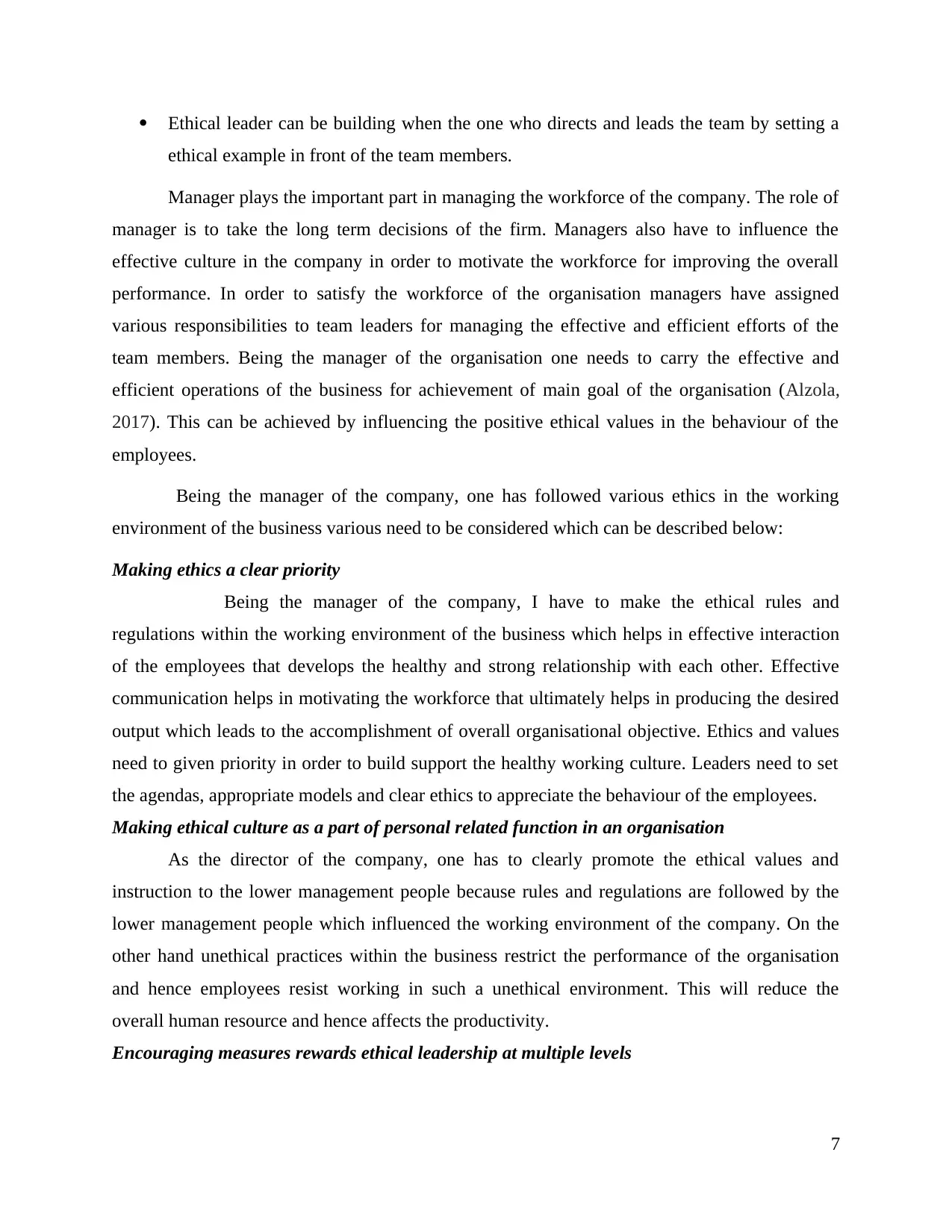
Ethical leader can be building when the one who directs and leads the team by setting a
ethical example in front of the team members.
Manager plays the important part in managing the workforce of the company. The role of
manager is to take the long term decisions of the firm. Managers also have to influence the
effective culture in the company in order to motivate the workforce for improving the overall
performance. In order to satisfy the workforce of the organisation managers have assigned
various responsibilities to team leaders for managing the effective and efficient efforts of the
team members. Being the manager of the organisation one needs to carry the effective and
efficient operations of the business for achievement of main goal of the organisation (Alzola,
2017). This can be achieved by influencing the positive ethical values in the behaviour of the
employees.
Being the manager of the company, one has followed various ethics in the working
environment of the business various need to be considered which can be described below:
Making ethics a clear priority
Being the manager of the company, I have to make the ethical rules and
regulations within the working environment of the business which helps in effective interaction
of the employees that develops the healthy and strong relationship with each other. Effective
communication helps in motivating the workforce that ultimately helps in producing the desired
output which leads to the accomplishment of overall organisational objective. Ethics and values
need to given priority in order to build support the healthy working culture. Leaders need to set
the agendas, appropriate models and clear ethics to appreciate the behaviour of the employees.
Making ethical culture as a part of personal related function in an organisation
As the director of the company, one has to clearly promote the ethical values and
instruction to the lower management people because rules and regulations are followed by the
lower management people which influenced the working environment of the company. On the
other hand unethical practices within the business restrict the performance of the organisation
and hence employees resist working in such a unethical environment. This will reduce the
overall human resource and hence affects the productivity.
Encouraging measures rewards ethical leadership at multiple levels
7
ethical example in front of the team members.
Manager plays the important part in managing the workforce of the company. The role of
manager is to take the long term decisions of the firm. Managers also have to influence the
effective culture in the company in order to motivate the workforce for improving the overall
performance. In order to satisfy the workforce of the organisation managers have assigned
various responsibilities to team leaders for managing the effective and efficient efforts of the
team members. Being the manager of the organisation one needs to carry the effective and
efficient operations of the business for achievement of main goal of the organisation (Alzola,
2017). This can be achieved by influencing the positive ethical values in the behaviour of the
employees.
Being the manager of the company, one has followed various ethics in the working
environment of the business various need to be considered which can be described below:
Making ethics a clear priority
Being the manager of the company, I have to make the ethical rules and
regulations within the working environment of the business which helps in effective interaction
of the employees that develops the healthy and strong relationship with each other. Effective
communication helps in motivating the workforce that ultimately helps in producing the desired
output which leads to the accomplishment of overall organisational objective. Ethics and values
need to given priority in order to build support the healthy working culture. Leaders need to set
the agendas, appropriate models and clear ethics to appreciate the behaviour of the employees.
Making ethical culture as a part of personal related function in an organisation
As the director of the company, one has to clearly promote the ethical values and
instruction to the lower management people because rules and regulations are followed by the
lower management people which influenced the working environment of the company. On the
other hand unethical practices within the business restrict the performance of the organisation
and hence employees resist working in such a unethical environment. This will reduce the
overall human resource and hence affects the productivity.
Encouraging measures rewards ethical leadership at multiple levels
7
⊘ This is a preview!⊘
Do you want full access?
Subscribe today to unlock all pages.

Trusted by 1+ million students worldwide
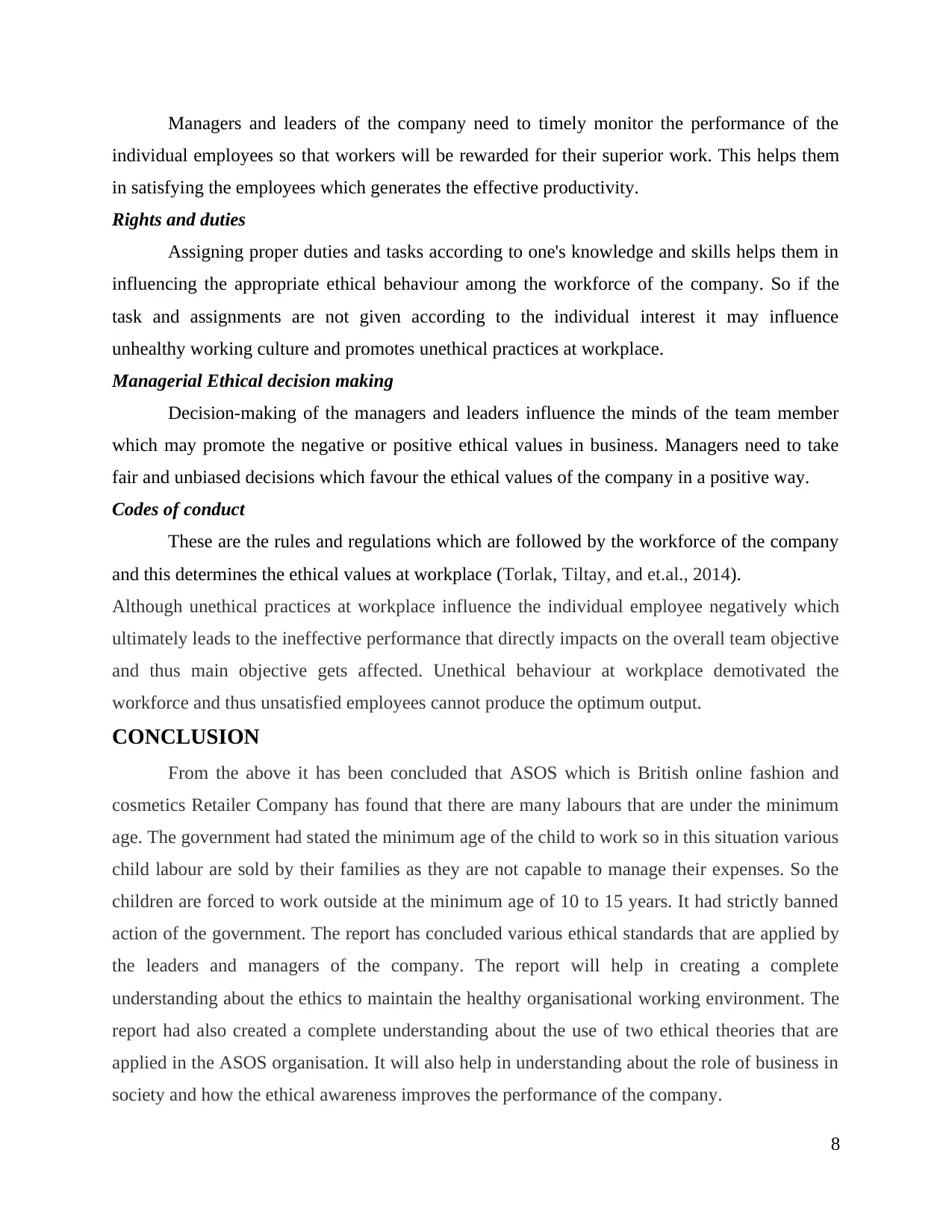
Managers and leaders of the company need to timely monitor the performance of the
individual employees so that workers will be rewarded for their superior work. This helps them
in satisfying the employees which generates the effective productivity.
Rights and duties
Assigning proper duties and tasks according to one's knowledge and skills helps them in
influencing the appropriate ethical behaviour among the workforce of the company. So if the
task and assignments are not given according to the individual interest it may influence
unhealthy working culture and promotes unethical practices at workplace.
Managerial Ethical decision making
Decision-making of the managers and leaders influence the minds of the team member
which may promote the negative or positive ethical values in business. Managers need to take
fair and unbiased decisions which favour the ethical values of the company in a positive way.
Codes of conduct
These are the rules and regulations which are followed by the workforce of the company
and this determines the ethical values at workplace (Torlak, Tiltay, and et.al., 2014).
Although unethical practices at workplace influence the individual employee negatively which
ultimately leads to the ineffective performance that directly impacts on the overall team objective
and thus main objective gets affected. Unethical behaviour at workplace demotivated the
workforce and thus unsatisfied employees cannot produce the optimum output.
CONCLUSION
From the above it has been concluded that ASOS which is British online fashion and
cosmetics Retailer Company has found that there are many labours that are under the minimum
age. The government had stated the minimum age of the child to work so in this situation various
child labour are sold by their families as they are not capable to manage their expenses. So the
children are forced to work outside at the minimum age of 10 to 15 years. It had strictly banned
action of the government. The report has concluded various ethical standards that are applied by
the leaders and managers of the company. The report will help in creating a complete
understanding about the ethics to maintain the healthy organisational working environment. The
report had also created a complete understanding about the use of two ethical theories that are
applied in the ASOS organisation. It will also help in understanding about the role of business in
society and how the ethical awareness improves the performance of the company.
8
individual employees so that workers will be rewarded for their superior work. This helps them
in satisfying the employees which generates the effective productivity.
Rights and duties
Assigning proper duties and tasks according to one's knowledge and skills helps them in
influencing the appropriate ethical behaviour among the workforce of the company. So if the
task and assignments are not given according to the individual interest it may influence
unhealthy working culture and promotes unethical practices at workplace.
Managerial Ethical decision making
Decision-making of the managers and leaders influence the minds of the team member
which may promote the negative or positive ethical values in business. Managers need to take
fair and unbiased decisions which favour the ethical values of the company in a positive way.
Codes of conduct
These are the rules and regulations which are followed by the workforce of the company
and this determines the ethical values at workplace (Torlak, Tiltay, and et.al., 2014).
Although unethical practices at workplace influence the individual employee negatively which
ultimately leads to the ineffective performance that directly impacts on the overall team objective
and thus main objective gets affected. Unethical behaviour at workplace demotivated the
workforce and thus unsatisfied employees cannot produce the optimum output.
CONCLUSION
From the above it has been concluded that ASOS which is British online fashion and
cosmetics Retailer Company has found that there are many labours that are under the minimum
age. The government had stated the minimum age of the child to work so in this situation various
child labour are sold by their families as they are not capable to manage their expenses. So the
children are forced to work outside at the minimum age of 10 to 15 years. It had strictly banned
action of the government. The report has concluded various ethical standards that are applied by
the leaders and managers of the company. The report will help in creating a complete
understanding about the ethics to maintain the healthy organisational working environment. The
report had also created a complete understanding about the use of two ethical theories that are
applied in the ASOS organisation. It will also help in understanding about the role of business in
society and how the ethical awareness improves the performance of the company.
8
Paraphrase This Document
Need a fresh take? Get an instant paraphrase of this document with our AI Paraphraser

9
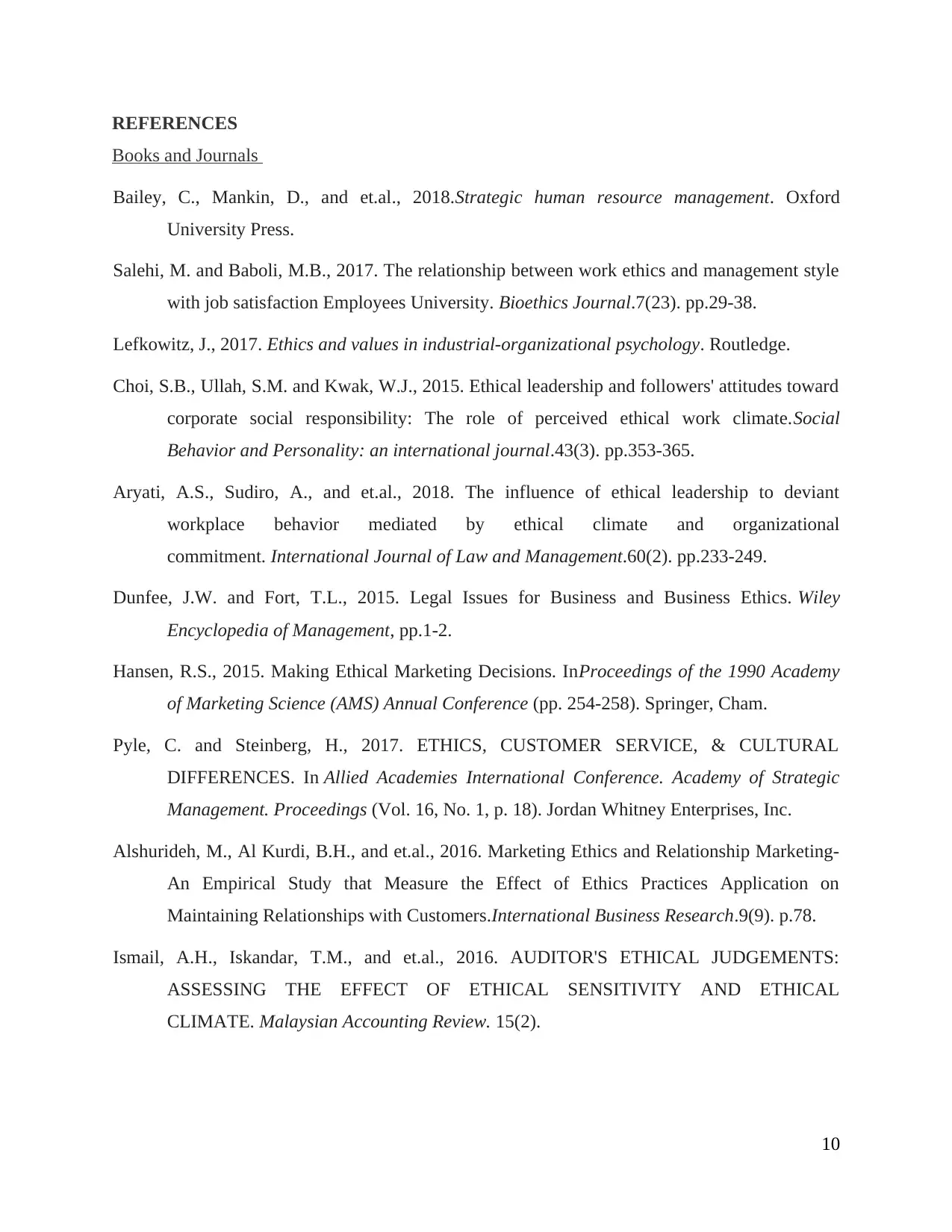
REFERENCES
Books and Journals
Bailey, C., Mankin, D., and et.al., 2018.Strategic human resource management. Oxford
University Press.
Salehi, M. and Baboli, M.B., 2017. The relationship between work ethics and management style
with job satisfaction Employees University. Bioethics Journal.7(23). pp.29-38.
Lefkowitz, J., 2017. Ethics and values in industrial-organizational psychology. Routledge.
Choi, S.B., Ullah, S.M. and Kwak, W.J., 2015. Ethical leadership and followers' attitudes toward
corporate social responsibility: The role of perceived ethical work climate.Social
Behavior and Personality: an international journal.43(3). pp.353-365.
Aryati, A.S., Sudiro, A., and et.al., 2018. The influence of ethical leadership to deviant
workplace behavior mediated by ethical climate and organizational
commitment. International Journal of Law and Management.60(2). pp.233-249.
Dunfee, J.W. and Fort, T.L., 2015. Legal Issues for Business and Business Ethics. Wiley
Encyclopedia of Management, pp.1-2.
Hansen, R.S., 2015. Making Ethical Marketing Decisions. InProceedings of the 1990 Academy
of Marketing Science (AMS) Annual Conference (pp. 254-258). Springer, Cham.
Pyle, C. and Steinberg, H., 2017. ETHICS, CUSTOMER SERVICE, & CULTURAL
DIFFERENCES. In Allied Academies International Conference. Academy of Strategic
Management. Proceedings (Vol. 16, No. 1, p. 18). Jordan Whitney Enterprises, Inc.
Alshurideh, M., Al Kurdi, B.H., and et.al., 2016. Marketing Ethics and Relationship Marketing-
An Empirical Study that Measure the Effect of Ethics Practices Application on
Maintaining Relationships with Customers.International Business Research.9(9). p.78.
Ismail, A.H., Iskandar, T.M., and et.al., 2016. AUDITOR'S ETHICAL JUDGEMENTS:
ASSESSING THE EFFECT OF ETHICAL SENSITIVITY AND ETHICAL
CLIMATE. Malaysian Accounting Review. 15(2).
10
Books and Journals
Bailey, C., Mankin, D., and et.al., 2018.Strategic human resource management. Oxford
University Press.
Salehi, M. and Baboli, M.B., 2017. The relationship between work ethics and management style
with job satisfaction Employees University. Bioethics Journal.7(23). pp.29-38.
Lefkowitz, J., 2017. Ethics and values in industrial-organizational psychology. Routledge.
Choi, S.B., Ullah, S.M. and Kwak, W.J., 2015. Ethical leadership and followers' attitudes toward
corporate social responsibility: The role of perceived ethical work climate.Social
Behavior and Personality: an international journal.43(3). pp.353-365.
Aryati, A.S., Sudiro, A., and et.al., 2018. The influence of ethical leadership to deviant
workplace behavior mediated by ethical climate and organizational
commitment. International Journal of Law and Management.60(2). pp.233-249.
Dunfee, J.W. and Fort, T.L., 2015. Legal Issues for Business and Business Ethics. Wiley
Encyclopedia of Management, pp.1-2.
Hansen, R.S., 2015. Making Ethical Marketing Decisions. InProceedings of the 1990 Academy
of Marketing Science (AMS) Annual Conference (pp. 254-258). Springer, Cham.
Pyle, C. and Steinberg, H., 2017. ETHICS, CUSTOMER SERVICE, & CULTURAL
DIFFERENCES. In Allied Academies International Conference. Academy of Strategic
Management. Proceedings (Vol. 16, No. 1, p. 18). Jordan Whitney Enterprises, Inc.
Alshurideh, M., Al Kurdi, B.H., and et.al., 2016. Marketing Ethics and Relationship Marketing-
An Empirical Study that Measure the Effect of Ethics Practices Application on
Maintaining Relationships with Customers.International Business Research.9(9). p.78.
Ismail, A.H., Iskandar, T.M., and et.al., 2016. AUDITOR'S ETHICAL JUDGEMENTS:
ASSESSING THE EFFECT OF ETHICAL SENSITIVITY AND ETHICAL
CLIMATE. Malaysian Accounting Review. 15(2).
10
⊘ This is a preview!⊘
Do you want full access?
Subscribe today to unlock all pages.

Trusted by 1+ million students worldwide
1 out of 13
Related Documents
Your All-in-One AI-Powered Toolkit for Academic Success.
+13062052269
info@desklib.com
Available 24*7 on WhatsApp / Email
![[object Object]](/_next/static/media/star-bottom.7253800d.svg)
Unlock your academic potential
Copyright © 2020–2025 A2Z Services. All Rights Reserved. Developed and managed by ZUCOL.



